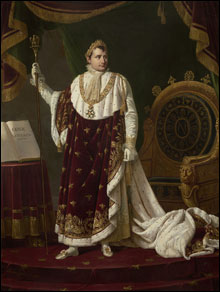
Robert Lefèvre, Portrait of Napoleon I in his
Coronation Robes (1812) |
We all know that the legendary general and emperor Napoleon Bonaparte (1769–1821) was short and that he was stylish, thanks to Jacques-Louis David’s portrait of him with his right hand tucked into the jacket of his chic little military outfit. Napoleon himself was well aware of the force that iconic images can have on the public imagination, and during his reign he promoted a new artistic style that allied his regime with the great civilizations of the past, especially classical Rome and Greece and ancient Egypt. The grandeur of Napoleon’s empire and the splendor of life at court is the focus of “SYMBOLS OF POWER: NAPOLEON AND THE ART OF THE EMPIRE STYLE, 1800–1815,” which opens at the Museum of Fine Arts on October 21 with nearly 200 examples of painting, sculpture, costumes, jewelry, silver, and furniture favored by Napoleon and his beloved Empress Josephine.
“Symbols of Power” surveys the decorative arts of late-18th and early-19th-century France with an eye toward Napoleon’s appropriation of symbols of supremacy, such as the Roman eagle and the laurel wreath, to underscore the military strength of France under his rule. Josephine was drawn to symbols as well; two porcelain ice-cream coolers adorned with flower and plant imagery represent her passion for botany, and her passion for passion is seen in the recurrent appearance of swans, butterflies, and female nudes — all metaphors for love and seduction.

Working during the same time period, but in a land (and a mindset) far, far away, American architect and woodcarver Samuel McIntire (1757–1811) spent his entire life in Salem designing more than 50 public and private buildings — among them the Peirce-Nichols House and the Gardner-Pingree House, both now owned by the Peabody Essex Museum. He also carved ornamental decoration for many of these buildings, as well as doing decorative carvings for furniture and sailing vessels. Opening at the Peabody Essex Museum on October 13, “SAMUEL MCINTIRE: CARVING AN AMERICAN STYLE” celebrates the 250th anniversary of McIntire’s birth with a retrospective exhibit of more than 200 carvings and sculpture. Many of his works incorporate symbols of America — eagles, portraits of George Washington. Others draw on the literary and artistic traditions of ancient Greece and Rome. His knowledge of the key elements of ancient Greek architecture gave his building an elegance and sophistication unrivaled in New England.
Berwick Research Institute has teamed with Somerville’s ArtsUnion to tempt your palate while raising questions about what we mean when we talk about “local food.” The one-day event “YUM LOCALE(E)” takes place in Union Square on October 13, and it’s part of the Berwick’s ongoing “Meet Me at the Table” series, which explores temporary social spaces and the many wonders of gathering together for meals. Participants will discuss attitudes about local food — and eat!
“Symbols of Power” at Museum of Fine Arts, 465 Huntington Ave, Boston | October 21–January 27 | 617.267.9300 | “Samuel MCIntire” at Peabody Essex Museum, East India Square, Salem | October 13–February 24 | 866.745.1876 | “Yum Local(e)” at Union Square, Somerville | October 13: 3-6 pm | 617.606.5552
On the Web
Museum of Fine Arts: www.mfa.org
Peabody Essex Museum: www.pem.org
“Yum Local(e)”: www.berwickinstitute.org